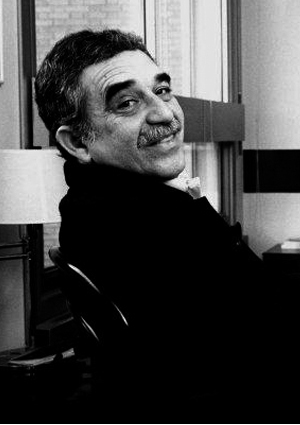Screenplay
Gabriel García Márquez
The only Colombia author to receive the Nobel Prize in Literature has died at age 87. Film was one of his greatest passions.
Known as “Gabo,” García Márquez was an author, journalist, screenwriter, and the father of “magic realism.” One Hundred Years of Solitude (1967), one of the most important works in world literature, has been translated into 35 languages and has sold more than 30 million copies. He won the Nobel Prize “for his novels and short stories, in which the fantastic and the realistic are combined in a richly composed world of imagination, reflecting a continent's life and conflicts.” He was the first Colombian and fourth Latin American to receive it. His work encompassed 28 short stories and 32 books, including novels, compilations, and journalistic works.
He always maintained a close relationship to film, because of the great admiration he felt for this form of story-telling. In 1954, he directed the surrealist short film La Langosta Azul (The Blue Lobster) together with Álvaro Cepeda Samudio, Enrique Grau Araújo, and Luis Vicens. In 1955 he traveled to Paris as a foreign correspondent for the newspaper El Espectador. He stayed in Europe and enrolled in the Centro Sperimentale di Cine in Rome. There, he had the experience of being the third assistant director of the film Too Bad She's Bad, featuring Sophia Loren, one of his most admired actresses. Meanwhile, he had to send reports to his paper on the 16th Venice Film Festival.
It was in those years when he wrote No One Writes to the Coronel. García Márquez said that the novel “has an entirely cinematographic structure and its narrative style is similar to that of a film; the novel develops by describing the characters’ movements as if they were being followed by a camera.“ Years later, in 1999, Arturo Ripstein made the film version of the novel.
After Europe, Gabo moved to Mexico in 1961, where he began to work as a screenwriter. There, he worked on the script to Roberto Gavaldón’s The Golden Cockerel (1964), based on the story of Juan Rulfo. While working on this film, he began his memorable friendship with the author Carlos Fuentes, who helped him “Mexicanize” the film’s dialogs. At around the same time, his story There are no Thieves in This Town was made into a film; García Márquez participated as an actor, playing the part of a box office ticket seller. He went on to write the screenplay for Tiempo de Morir (Time to Die) (1966), directed by Arturo Ripstein when he was only 21 years old. Years later, Jorge Alí Triana made a new version of the film in Colombia.
His other screenwriting works in this period included Dangerous Game ("HO” segment) (1966) by Luis Alcoriza and Arturo Ripstein; Patsy, My Love (1968) by Manuel Michel; Omen (1974) by Luis Alcoriza; The Widow of Montiel (1979) by Miguel Littín; María de Mi Corazón (Maria of my Heart) (1979) by Jaime Humberto Hermosillo; The Year of the Plague (1979) by Felipe Cazals (adaptation of the Daniel Defoe book A Journal of the Plague Year), and Eréndira (1983) by Ruy Guerra.
The same year that he received the Nobel Prize, he was a juror at the Cannes Film Festival. In 1986, García Márquez embarked on a new project with the Argentinian Fernando Birri and the Cuban Julio García Espinosa, his classmates during his studies in Italy. They founded the New Latin American Film Foundation and the International School of Film and TV in San Antonio de los Baños, Cuba, with the goal of teaching, producing and promoting film in the region.
Film versions of García Márquez’s work included the adaptation in 1987 of Chronicle of a Death Foretold, directed by Francisco Rosi; A Very Old Man with Enormous Wings by Fernando Birri (1988), Miracle in Rome by Lisandro Duque Naranjo (1989), Fable of the Beautiful Pigeon Fancier by Ruy Guerra (1988), and Cartas del Parque (Letters from a Park) by Tomás Gutiérrez Alea (1989). In 1996, García Márquez and Estela Malagón wrote the adaptation of Sophocles’s Oedipus Rex for the Colombian film Oedipus Mayor by Jorge Alí Triana; later, he wrote The Invisible Children (2001) with Lisandro Duque Naranjo. In 2007 Mike Newell’s film Love in the Time of Cholera was released, and 2010 saw the premiere of Of Love and Other Demons, a Colombian-Costa Rican co-production directed by Hilda Hidalgo. In 2013, Memories of My Melancholy Whores premiered; this Danish-Mexican co-production was directed by the Dane Henning Carlsen and adapted for film by French screenwriter Jean-Claude Carrière.
On Colombia television, RTI produced In Evil Hour, directed by Bernardo Romero Pereiro, broadcast in 1977. Years later, in 1991, the soap opera María was produced, based on the novel by Jorge Isaacs, adapted by García Márquez together with Lisandro Duque Naranjo and Manuel Arias. And in 1993, he co-wrote with Stella Malagón Crónicas de Una Generación Trágica, directed by Jorge Alí Triana.
Filming
Screenplay
OF LOVE AND OTHER DEMONS (2010)
Screenplay
EDIPO ALCALDE (1996)
Screenplay
TIEMPO DE MORIR (1985)


